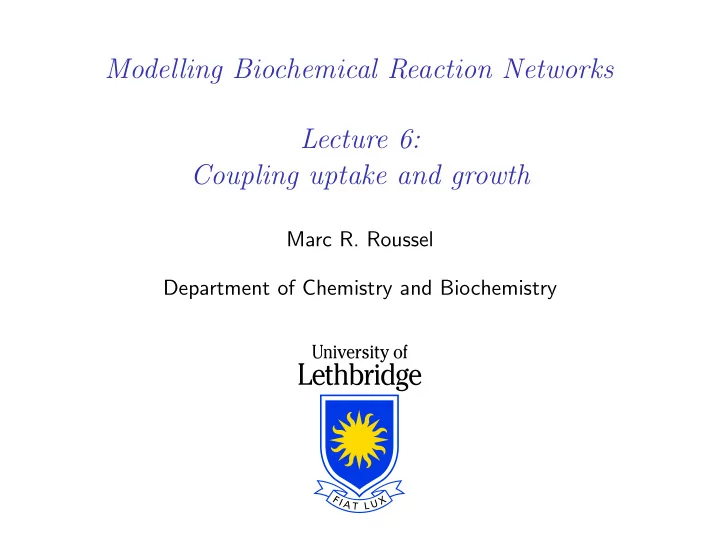

Modelling Biochemical Reaction Networks Lecture 6: Coupling uptake and growth Marc R. Roussel Department of Chemistry and Biochemistry
Uptake model ◮ Recall: Last lecture, we derived equations for the rate of passive transport of glucose into yeast cells ( v t ). We add a glucose utilization term ( v u ) to the equation for the internal glucose: d [G (in) ] = v t / V cells − v u dt d [G (out) ] and = − v t / V medium dt v t = v t , max [G (out) ] with [G (out) ] + K t
Growth modeling ◮ In cell cultures, we typically measure biomass or dry mass rather than the number of cells. ◮ The simplest way to model growth is to add a pseudo-reaction for the conversion of glucose to biomass (B): v u G (in) → Y g B − ◮ Y g is the biomass yield, the amount of biomass obtained per unit glucose metabolized. ◮ v u is often of the Michaelis-Menten form to recognize the fact that there is a maximal rate of growth: v u = v u , max [G (in) ] [G (in) ] + K u
Growth modeling ◮ The rate equation for biomass growth is then dB dt = Y g v u ◮ Note: B is normally measured in g/L.
Connections between growth and uptake ◮ Several quantities that appear as parameters in fact depend on some of the variables: ◮ V cells ∝ B ◮ v t , max = k cat T 0 and T 0 ∝ B [ k cat = k 3 / (1 + K 2 )] ◮ v u , max ∝ B
Parameter estimates Glucose transport by Hxt7 ◮ k cat ≈ 200 s − 1 Source: Ye et al., Yeast 18 , 1257 (2001). ◮ K t ≈ 2 mM Source: Ye et al., Yeast 18 , 1257 (2001). ◮ T 0 ≈ (2 × 10 4 molecules / cell) V medium B N A (biomass / cell) Source for density of transporters: Ye et al., Yeast 18 , 1257 (2001). A typical yeast cell weighs about 60 pg (an oft repeated estimate, e.g. http://www.weizmann.ac.il/plants/Milo/ images/YeastSize-Feb2010.pdf ) of which 60% is water (Illmer et al., FEMS Microbiol. Lett. 178 , 135, 1999). The biomass per cell is therefore about 24 pg/cell.
Parameter estimates Glucose transport by Hxt7 ◮ Because the cells occupy only a small fraction of the total volume, V medium ≈ V culture . This varies from experiment to experiment, but might typically be 200 mL for an experiment in a shaker flask. This gives T 0 ≈ (3 × 10 − 10 mol L g − 1 ) B . ◮ Therefore v t , max ≈ (6 × 10 − 8 mol L g − 1 s − 1 ) B ◮ The volume of cells in the solution can similarly be related to B assuming that yeast cells have a density ( ρ cells ) similar to that of water (about 1000 g/L): V cells = BV culture /ρ cells 0 . 2 L 1000 g / L B = (2 × 10 − 4 L 2 / g) B =
Parameter estimates Growth parameters ◮ Y g = 0 . 45 g biomass/g glucose Source: Ertugay and Hamamci, Folia Microbiol. 42 , 463 (1997). ◮ Write v u , max = µ max B . ◮ µ is a first-order rate constant for glucose utilization, which is proportional to biomass production. ◮ µ max = 0 . 38 h − 1 Source: Ye et al., Yeast 18 , 1257 (2001). ◮ Another estimate: µ is related to the doubling time t 2 by µ = ln 2 / t 2 . ◮ Minimum doubling time for yeast grown on glucose: 75 min Source: Tyson et al., J. Bacteriol. 138 , 92 (1979). ◮ µ = 0 . 55 h − 1
Parameter estimates Growth parameters ◮ I have had no luck tracking down data that would allow me to calculate K u . ◮ Leave it as a disposable parameter ◮ Investigate its effect ◮ Fit to data?
Initial conditions ◮ Starved cells: [G (in) ](0) = 0. ◮ Ye and coworkers studied Hxt7 in 1% glucose solution, corresponding to about [G (out) ](0) = 55 mM. ◮ They started their experiments with a culture diluted to an optical density (OD) of 0.2 at 600 nm. ◮ An OD of 1 corresponds to 3 × 10 7 cells / mL so we’re starting with about 6 × 10 6 cells / mL. Source: Ausubel et al., Short protocols in molecular biology , 5th ed., Vol. 2. ◮ Using the typical cell mass of 60 pg and 60% water content, this gives B (0) ≈ 0 . 1 g / L.
Recommend
More recommend